Digital electronics play a very effective role in the operation of storage-based systems, transmitting any information in the modern technological environment. Today, I will discuss an interpreter in the world of digital electronics. Now, surely everyone is wondering who this interpreter is? These interpreters are none other than encoders and decoders.

How does an encoder-decoder work like an interpreter?
Suppose, you are the owner of a very well-known company. Now, there are some people in Saudi Arabia who want to do business with you. Now, you don’t understand Arabic. So, you have to appoint someone who can both understand and speak Arabic well. In this way, there won’t arise any problem between you and your client while conducting your business. Now, in the world of digital electronics, the encoders and decoders work just like these interpreters.
Machine, human & an Interpreter in the world of Digital Electronics
Although people make machines, these machines cannot do any work by themselves. They need instructions to perform any work or operate. So, the machine works according to that instruction. Technically speaking, the hardware is nothing more than a dumb device. It is so dumb that it can not function by itself. It needs specific instructions to perform simple work. The programming language works as the orders given by the programmer. Thus, it serves as a slave to human commands. But, the language of machine and man is not the same. All the languages we communicate with are not understandable to the machines.

Again, the language of the machine is not something that we can easily understand. Here, you can think of the machine as the Saudi client and the machine user as the owner of the company. So, the encoders and decoders act as interpreters between these machines and humans. The encoder converts the human language into machine language. Again, the decoder does the opposite. The decoder decodes the machine language into human language.
Functions and usefulness of the Encoder
The encoder can reduce effective storage size by converting data to another format. The use of encoders in electrical circuits is to compress multiple binary inputs to a small number of outputs. In addition to working as a digital to analog converter (DAC) and analog to digital converter (ADC), the use of electronic encoder is to convert input bitstreams to a standard code for transmission in telecommunications. This is an Interpreter in the world of Digital Electronics, the use of which is to convert the bitstreams.

Some transducers also act as encoders. E.g.
- Rotary encoder.
- Linear encoder.
The use of rotary encoders is to convert the angular position of moving elements (such as a shaft). Linear encoders perform similar functions but on a linear scale. The usage of them are mostly in mechatronics and robotics. Another aspect of encoding is for security purposes. The encryption of data uses an encoder before data sending. So, encoders are used to secure data. In modern media technology, encoding is used in both audio and video. The use of encoders is also to improve security standards in web technologies. E-mail technology uses encoders to protect information.
Functions and usefulness of the Decoder

The decoder performs the opposite function of the encoder.
The decoder reverses the encoding process by converting the data to its previous format or other accessible formats.
For example, in electrical circuits, if a signal is encoded using an analog to digital converter. Then, the receiver has to decode the signal using a digital to analog converter to recover the original analog signal. In this case, ADC (Analog to Digital Converter) acts as the encoder and DAC (Digital to Analog Converter) acts as the decoder.
The decoders are also playing a huge role in telecommunications, and digital networking systems.
Encoders and decoders
The difference
- An encoder is a digital electronic circuit. This circuit converts human language or analog signals into binary signals or machine language. Again, the decoder does the opposite.
- The encoder is connected to the keyboard as input. On the contrary, the decoder is connected to the memory of the computer or any other device.
- From an output of 2^n, n number of binary inputs can be found in the case of the encoders. On the contrary, in decoders, 2^n output can be gained from n number of binary inputs.
Check more articles –
1. Optical Ground Wire | Protector & Communication bridge in transmission line
2. What are the causes of Load shedding? The general concept of the people and it’s technical reality



